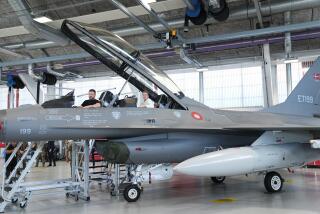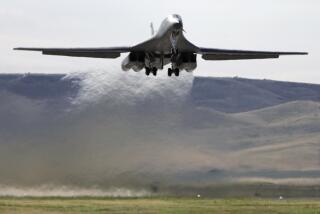Sky-high overruns, safety ills plague jet
- Share via
It’s the most expensive fighter jet ever built. Yet the F-22 Raptor has never seen a day of combat, and its future is clouded by a government safety investigation that has grounded the jet for months.
The fleet of 158 F-22s has been sidelined since May 3, after more than a dozen incidents in which oxygen was cut off to pilots, making them woozy. The malfunction is suspected of contributing to at least one fatal accident.
At an estimated cost of $412 million each, the F-22s amount to about $65 billion sitting on the tarmac. The grounding is the latest dark chapter for an aircraft plagued by problems, and whose need was called into question even before its first test flight.
The sleek, diamond-winged fighter was conceived during the Cold War in the early 1980s to thump a new generation of Soviet fighter jets in dogfights. But with the collapse of the Soviet Union, the Soviet fighters that the U.S. military planners feared never moved beyond development and were never built.
Now, while other U.S. warplanes pummel targets, the F-22 has sat silently throughout battles in Afghanistan. It has gone unused in Iraq. There has been no call for it in the conflict above Libya.
“For all that gigantic cost, you have a system you can’t even use,” said Winslow T. Wheeler, a defense budget specialist and frequent Pentagon critic at the Center for Defense Information. “It’s a fundamental explanation on how the country has gotten itself in the financial mess that it’s in today.”
Designed in Burbank and built in Marietta, Ga., the F-22 won the final go-ahead from Congress in 1991, thanks in part to a lobbying campaign by the plane’s manufacturer, Lockheed Martin Corp. -- then Lockheed Corp. -- and its nearly 1,100 subcontractors in 44 states.
“The Cold War was over, it didn’t make any sense to go forward with the program,” said Thomas Christie, a retired official who worked 50 years at the Pentagon. “But the Air Force built up such a large constituency up on the Hill that it couldn’t be killed.”
The Air Force wanted an engineering marvel with unmatched features. Lockheed Martin delivered.
F-22 engines have thrust-vectoring nozzles that can move up and down, making the plane exceptionally agile. It can reach supersonic speeds without using afterburners, enabling the plane to fly faster and farther. It’s also packed with cutting-edge radar and sensors, allowing the pilot to identify, track and shoot an aircraft before the enemy pilot can detect the F-22.
“The Air Force piled it all on,” said Pierre Sprey, an aeronautical engineer who helped design the F-16 and A-10 jets. “It became a vehicle to carry a laundry list of technologies. The plane is a textbook case on the dangers of complexity.”
As the Air Force saw more opportunities for design changes, the F-22 grew in cost. When it first entered service in 2005, it didn’t take long for problems to arise.
In 2006, an F-22 pilot was stuck in the plane on the ground for five hours because the canopy wouldn’t pop open. Firefighters had to cut the pilot out. A replacement canopy cost about $71,000, the Air Force said.
In 2007, a software error in the navigational systems caused 12 F-22s to turn around from a flight to Okinawa, Japan, from Joint Base Pearl Harbor-Hickam in Hawaii. Six days later, engineers corrected the error at a cost of between $200,000 and $300,000, the Air Force estimated.
Last year, the fighters were inspected for rust corrosion “due to poorly designed drainage in the cockpit,” according to the House Armed Services Committee. Fourteen F-22s had rusting parts in the cockpit replaced, the Air Force said.
Corrosion has also been an issue with the plane’s radar-evading skin, which, the U.S. Government Accountability Office said, is “difficult to manage and maintain, requiring nearly twice the number of maintenance personnel as anticipated.”
The plane takes about 3,000 people to maintain, the Air Force said. The service calculated that for every hour in the air, the F-22 spends 45 hours undergoing maintenance.
Two decades ago, the U.S. government planned to buy 648 of the fighters for $139 million apiece; the cost has almost tripled since then to $412 million, the Government Accountability Office said.
Recently retired Defense Secretary Robert M. Gates ended the purchase in 2009 at 188 planes, only a handful of which are still being built. The $273-million increase per plane translates to $51.3 billion in lost buying power for the F-22 program.
“The reality is we are fighting two wars, in Iraq and Afghanistan, and the F-22 has not performed a single mission in either theater,” Gates told a congressional panel in 2008.
Air Force officials said the F-22 hadn’t been used in conflicts because its technology wasn’t needed. They added that all aircraft have problems that crop up, and that the F-22 was worth the high price tag because it was the “most advanced fighter aircraft, with unrivaled capabilities.”
“The aircraft was designed for high-threat environments, not what we’ve seen in Iraq, Afghanistan and Libya,” said Lt. Col. E. John Teichert, who until recently commanded the F-22 squadron at Edwards Air Force Base. “If the F-22 prevents a military engagement with another country, it is well worth the money.”
Even though the F-22 has never been sent over a war zone, it has experienced seven major crashes with two casualties -- one of which may have been linked to the oxygen malfunction.
Capt. Jeff Haney, 31, was killed in an F-22 after a crash in the Alaskan wilderness in November near Joint Base Elmendorf-Richardson. An Air Force investigation is examining the oxygen system as part of its probe.
The Air Force said the order in May to keep the planes grounded was caused by 14 instances since June 2008 in which pilots experienced sickness related to bad oxygen flow.
The Air Force said its investigation into the accident and oxygen problems “is currently scheduled to be completed and delivered to the secretary of the Air Force this coming fall.”
The oxygen system problems have compelled the government to examine its forthcoming F-35 Joint Strike Fighter, which is also made by Lockheed. The F-35 is smaller than the F-22 and will be used jointly by the Navy, Marines and Air Force. The Pentagon plans to buy 2,457 F-35s.
John P. Jumper, a retired Air Force general, former Air Force chief of staff to President George W. Bush and fierce backer of the F-22 program, said the F-22 problems need to be resolved soon so the planes and pilots return to service.
“It’s very troublesome,” he said. “This is the sort of thing that deserves a thorough examination so it never can happen again.”
More to Read
Inside the business of entertainment
The Wide Shot brings you news, analysis and insights on everything from streaming wars to production — and what it all means for the future.
You may occasionally receive promotional content from the Los Angeles Times.











